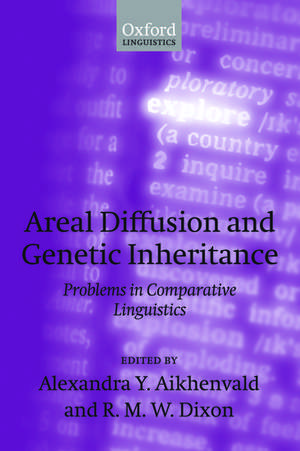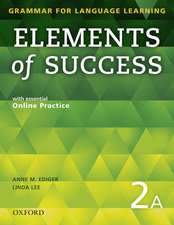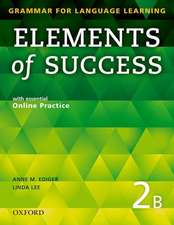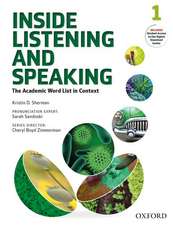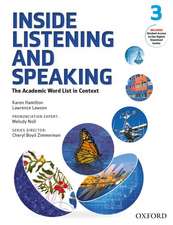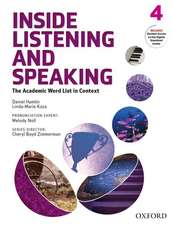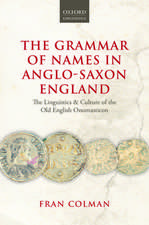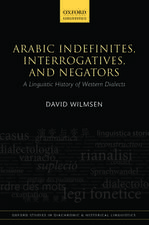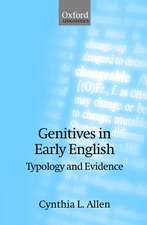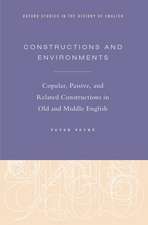Areal Diffusion and Genetic Inheritance: Problems in Comparative Linguistics: Explorations in Linguistic Typology
Editat de Alexandra Y. Aikhenvald, R. M. W. Dixonen Limba Engleză Paperback – 2 mar 2006
| Toate formatele și edițiile | Preț | Express |
|---|---|---|
| Paperback (1) | 423.20 lei 31-37 zile | |
| OUP OXFORD – 2 mar 2006 | 423.20 lei 31-37 zile | |
| Hardback (1) | 533.64 lei 31-37 zile | |
| OUP OXFORD – 22 noi 2001 | 533.64 lei 31-37 zile |
Preț: 423.20 lei
Preț vechi: 517.67 lei
-18% Nou
Puncte Express: 635
Preț estimativ în valută:
80.99€ • 87.94$ • 68.03£
80.99€ • 87.94$ • 68.03£
Carte tipărită la comandă
Livrare economică 11-17 aprilie
Preluare comenzi: 021 569.72.76
Specificații
ISBN-13: 9780199283088
ISBN-10: 0199283087
Pagini: 470
Ilustrații: Numerous maps, tables and line drawings
Dimensiuni: 156 x 234 x 27 mm
Greutate: 0.71 kg
Ediția:Revised
Editura: OUP OXFORD
Colecția OUP Oxford
Seria Explorations in Linguistic Typology
Locul publicării:Oxford, United Kingdom
ISBN-10: 0199283087
Pagini: 470
Ilustrații: Numerous maps, tables and line drawings
Dimensiuni: 156 x 234 x 27 mm
Greutate: 0.71 kg
Ediția:Revised
Editura: OUP OXFORD
Colecția OUP Oxford
Seria Explorations in Linguistic Typology
Locul publicării:Oxford, United Kingdom
Recenzii
extremely rich, competent, and well-edited.
Review from previous edition This book is a pleasure to sample, and will serve as a resource for years to come. The salutary lesson that emerges from every chapter is that diffusion studies are necessarily complementary to genetic studies, and that our methodology for studying various types of contact needs to be extended and refined.
Highly recommended for all those interested in historical linguistics, linguistic typology, language contact and language change ... this book represents a good opportunity to meditate, on the one side, on models of language evolution and, on the other side, on actual phenomena of language change.
Invaluable ... the uniformly high quality of the contributions demonstrates that all contributors know whereof they speak ... The geographical range of the contributions is impressive. ...The quality of the production is high.
... A book worth acquiring and reading.
Review from previous edition This book is a pleasure to sample, and will serve as a resource for years to come. The salutary lesson that emerges from every chapter is that diffusion studies are necessarily complementary to genetic studies, and that our methodology for studying various types of contact needs to be extended and refined.
Highly recommended for all those interested in historical linguistics, linguistic typology, language contact and language change ... this book represents a good opportunity to meditate, on the one side, on models of language evolution and, on the other side, on actual phenomena of language change.
Invaluable ... the uniformly high quality of the contributions demonstrates that all contributors know whereof they speak ... The geographical range of the contributions is impressive. ...The quality of the production is high.
... A book worth acquiring and reading.
Notă biografică
Alexandra Y. Aikhenvald is Professor and Associate Director of the Research Centre for Linguistic Typology at La Trobe University. She has worked on descriptive and historical aspects of Berber languages and has published, in Russian, a grammar of modern Hebrew (1990). She is a major authority on languages of the Arawak family, from northern Amazonia, and has written grammars of Bare (1995) (based on work with the last speaker who has since died) and Warekena (1998), plus A Grammar of Tariana, from Northwest Amazonia (CUP 2003), in addition to essays on various typological and areal features of South American languages. Her monographs, Classifiers: A Typology of Noun Categorization Devices (2000, paperback reissue 2003), Language Contact in Amazonia (2002) and Evidentiality (2004) are published by Oxford University Press. She is currently working on a reference grammar of Manambu, from the Sepik area of New Guinea.R. M. W. Dixon is Professor and Director of the Research Centre for Linguistic Typology at La Trobe University. He has published grammars of a number of Australian languages (including Dyirbal and Yidiñ), in addition to A Grammar of Boumaa Fijian (University of Chicago Press 1988), The Jarawara Language of Southern Amazonia (OUP 2004), and A Semantic Approach to English Grammar (OUP 2005). His works on typological theory include Where Have All the Adjectives Gone? and Other Essays in Semantics and Syntax (Mouton,1982) and Ergativity (CUP 1994). The Rise and Fall of Languages (CUP 1997) expounded a punctuated equilibrium model for language development: this is the basis for his detailed case study Australian Languages: Their Nature and Development (CUP 2002).
